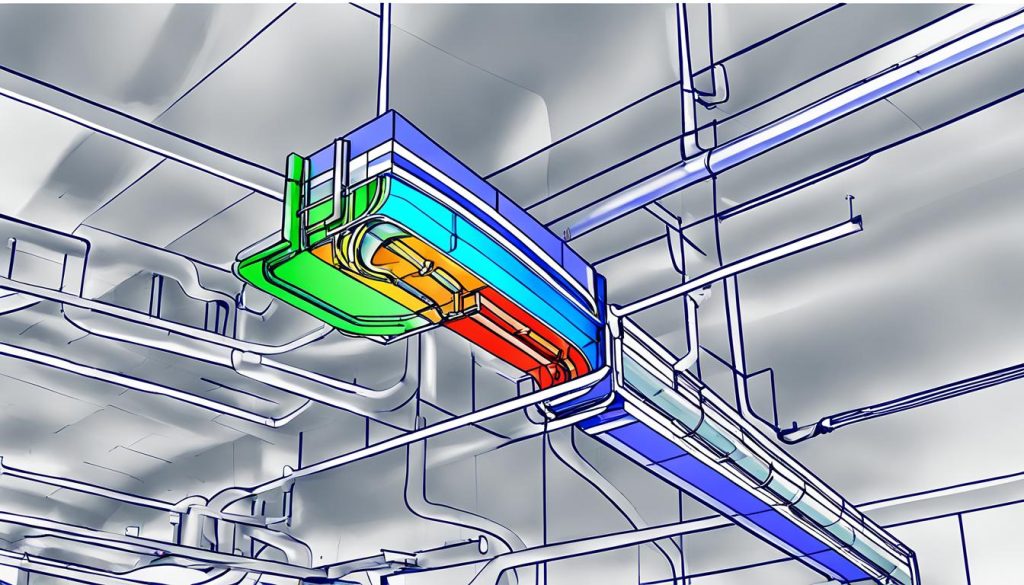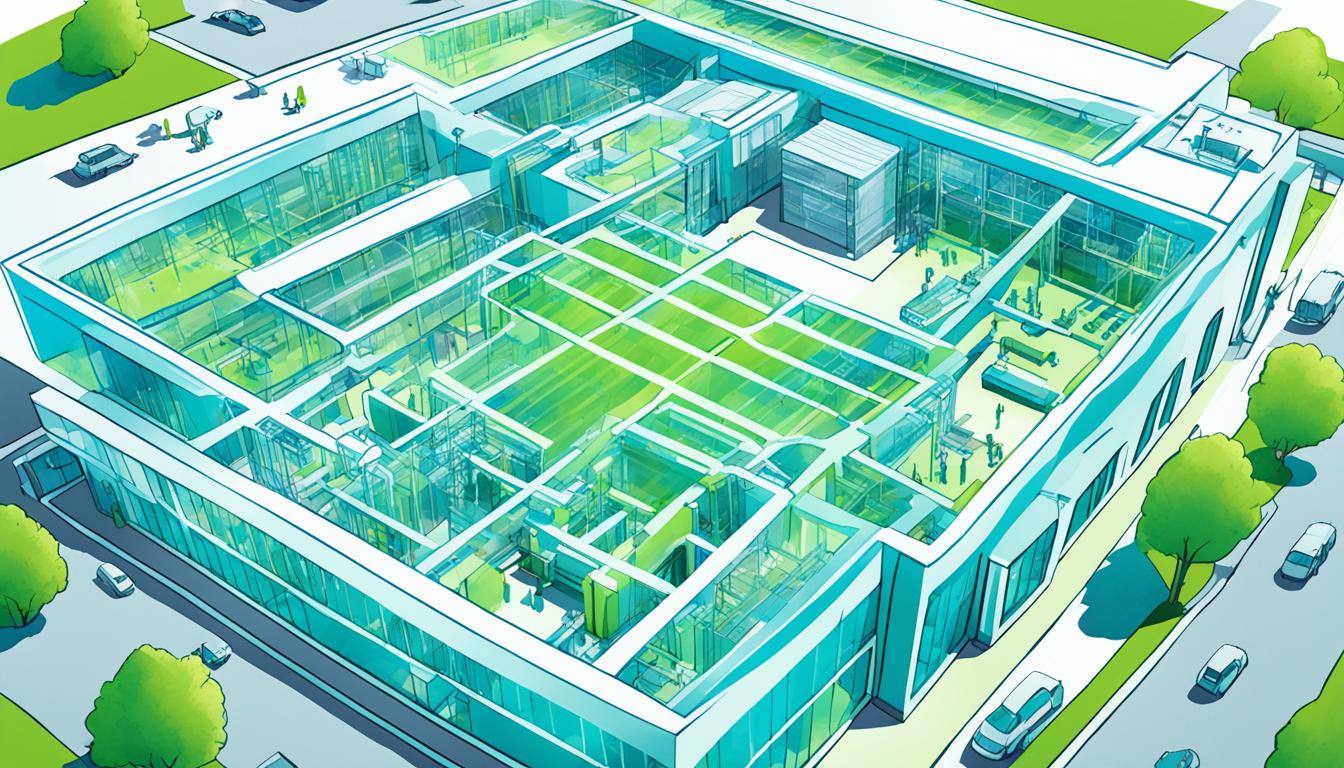Designing efficient ductwork systems is easier with airflow simulation. By using computational fluid dynamics (CFD), you can improve HVAC performance. This method lets you model and analyze airflow patterns. It helps reduce energy use and enhance indoor air quality.
Airflow modeling lets you check out full design spaces for HVAC products. It works at both the component and spatial levels. With cloud-native engineering simulation software like SimScale, you save money and time. You avoid the need for physical prototypes and their trial-and-error process.
Getting the right duct size is key for a top-performing HVAC system. Through ventilation optimization, you can make ductwork layouts that spread air evenly and cut down on pressure losses. This leads to better energy efficiency and overall system performance.
Understanding the Importance of Efficient Ductwork Design
Efficient ductwork design is key to your HVAC system’s success. It impacts energy use, comfort, and air quality. By planning your duct layout and analyzing pressure drops, you can make your system work better for your space.
Impact on HVAC Performance
Good ductwork makes your HVAC system run at its best. It cuts down on air resistance, easing the system’s workload and making it last longer. The right size and layout stop problems like uneven heating or cooling. This means you stay comfortable and use less energy.
Energy Efficiency Considerations
Optimized ductwork saves energy. It cuts down on air leaks and pressure drops, lowering your bills. With efficient ducts, your system uses less power to move air. This means it runs less and works better overall.
Indoor Air Quality Implications
The design of your ducts affects the air you breathe. The right size and seal keep out dust, allergens, and pollutants. This is crucial with more awareness of airborne diseases. Efficient ductwork also keeps humidity in check, making the air cleaner and more comfortable.
| Aspect | Impact of Efficient Ductwork |
|---|---|
| Energy Consumption | Reduced by up to 30% |
| Indoor Air Quality | Improved filtration and circulation |
| System Lifespan | Extended by 5-10 years |
| Comfort Levels | Enhanced temperature consistency |
Putting a focus on efficient ductwork design makes your indoor space better. You’ll save on energy, breathe cleaner air, and your HVAC system will work better. It’s not just about saving money; it’s about making your home healthier and more comfortable.
Fundamentals of Airflow Simulation in HVAC Design
Airflow simulation changes the game in HVAC design. It lets you test ductwork systems with CAD models before building them. This saves time and money by avoiding costly mistakes.
Computational fluid dynamics (CFD) is the tech behind airflow modeling. It uses complex math to predict air movement. With CFD, you can see pressure drops, flow patterns, and velocities in your designs.
Cloud-based CFD tools make airflow simulation easy. You can run simulations from any computer with internet. No need for powerful workstations or expensive software licenses.
Ventilation optimization is a key goal of airflow simulation. By adjusting your models, you can find the best duct layouts. This leads to better air distribution and lower energy costs.
HVAC components that benefit from CFD analysis include:
- Air handling units (AHUs)
- Fans and blowers
- Dampers and louvers
- Air diffusers
Simulating these parts helps predict their performance before installation. This avoids costly mistakes and ensures your HVAC system works well.
Key Components of Ductwork Systems
Understanding the essential HVAC components is key to designing efficient ductwork systems. Let’s look at the main parts that make up these systems. They ensure good airflow and comfort inside.
Air Handling Units (AHUs)
AHUs are the core of HVAC systems. They move, clean, and condition the air inside. When picking AHUs, think about their size, how much air they can handle, and where they fit in the ductwork. Good AHUs boost system performance and save energy.
Fans and Blowers
Fans and blowers push conditioned air around a building. Choose them based on how much air you need and the pressure in the ducts. Don’t forget to consider how they vibrate to keep the noise down and protect the building.
Dampers and Louvres
Dampers and louvres control airflow and pressure in ducts. They help spread air evenly and can be used to zone off certain areas. Make sure they’re the right size and in the best spot for the best system performance.
Air Filters and Diffusers
Air filters clean the air, making it healthier to breathe. Diffusers spread the air out evenly in rooms. When picking these, think about how much pressure they add, how well they filter, and how they spread the air.
| Component | Function | Design Considerations |
|---|---|---|
| Air Handling Units | Air circulation and conditioning | Size, capacity, energy efficiency |
| Fans and Blowers | Airflow generation | Airflow rate, static pressure, noise control |
| Dampers | Airflow and pressure control | Placement, sizing, automation |
| Air Filters | Air purification | Filtration efficiency, pressure drop |
| Diffusers | Air distribution | Throw distance, noise levels, aesthetics |
By picking and putting these HVAC parts together, you can make a ductwork system that works well and keeps people comfortable. Always think about what your project needs when designing and sizing each part.
Pressure Drop Analysis in Ductwork Design

Pressure drop analysis is key in designing ductwork. It affects how well HVAC systems work and how air flows. You must think about how each part changes air pressure as it moves through the system.
Every part of an air handling unit (AHU) slows down airflow. This slowing is most seen when air goes through dampers, grills, and louvres. The way these parts are angled can greatly change pressure drops. This, in turn, affects how efficient the system is.
To make your ductwork better, keep these points in mind:
- Component angles
- Fin design
- Guiding vanes
- System layout
Looking at pressure drops at different flow rates and temperatures helps you improve your ductwork. Computational Fluid Dynamics (CFD) software is a great tool for this. It lets you figure out pressure drops all over the system.
| Component | Typical Pressure Drop Range (Pa) | Optimization Technique |
|---|---|---|
| Dampers | 5-50 | Adjust fin angles |
| Grills | 10-30 | Optimize grill design |
| Louvres | 15-40 | Add guiding vanes |
| Air Filters | 50-250 | Regular maintenance |
Doing a deep pressure drop analysis and using airflow optimization can really boost your HVAC’s performance and energy use. A well-made ductwork system is key to a top-notch HVAC setup.
Design Efficient Ductwork with Airflow Simulation
Airflow simulation changes how we design ductwork, giving us exact details on how systems work. Using computational fluid dynamics, we can make HVAC systems use less energy and improve the air we breathe indoors.
Benefits of Computational Fluid Dynamics (CFD)
CFD shows airflow in three dimensions, taking into account all physical factors and shapes. This tech lets us:
- Predict pressure loss in HVAC ducts
- Improve HVAC designs step by step
- Make inlet duct designs work better
Setting Up Digital Prototypes
Creating digital prototypes is key for designing ductwork well. With cloud-based tools, you can:
- Check out many design versions at once
- Efficiently compare different duct setups
- Cut down on costs and time for physical prototypes
Analyzing Flow Patterns and Velocities
Looking at flow patterns helps make ductwork more efficient. Through CFD simulations, we can:
- See how air moves through the system
- Spot areas with turbulence or no air movement
- Adjust diffuser placement for the room’s needs
By using computational fluid dynamics, digital prototypes, and flow pattern analysis, you’ll make ductwork systems that work better and save energy.
Optimizing Duct Sizing and Layout
Getting duct sizing and layout right is key for efficient HVAC systems. It’s important for both home and industrial HVAC setups. Making your ductwork better can really boost energy efficiency and how well your system works.
ACCA Manual D Guidelines
The Air Conditioning Contractors of America (ACCA) Manual D is a must-have for home HVAC systems. It gives clear steps for sizing ducts, making sure air flows well in your home.

Industrial vs. Residential Considerations
Industrial HVAC systems are more complex than home setups. They handle more air and might deal with dangerous air. So, they need to meet safety standards, keep air clean, and fit specific needs.
| Aspect | Residential HVAC | Industrial HVAC |
|---|---|---|
| Primary Focus | Comfort | Process requirements |
| Air Volume | Lower | Higher |
| Safety Considerations | Basic | Advanced |
Balancing Airflow Distribution
Getting air to flow evenly is crucial for both home and industrial HVAC. This means tweaking dampers and registers to make sure each area gets the right air. Doing this makes your system more comfortable, saves energy, and lasts longer.
By paying attention to duct sizing and layout, you can make an HVAC system that works well for you. This is true whether it’s for your home or a business.
Addressing Common Ductwork Design Challenges
HVAC design challenges can be tough, but you can beat them with the right strategy. Ductwork optimization is key to making HVAC systems work better. Using airflow simulation helps solve common problems and boosts performance.
One big challenge is cutting down pressure losses in ductwork. This impacts energy use and system efficiency. Engineers use CFD simulations to check out different duct setups. These simulations spot high pressure drop areas and guide design changes.
Another challenge is making sure air flows evenly throughout the system. If air doesn’t spread out right, it can cause comfort issues and poor air quality. Simulation tools let designers see how air moves and make changes for better balance.
| Challenge | Solution | Benefits |
|---|---|---|
| Pressure losses | CFD simulations | Reduced energy consumption |
| Uneven airflow | Flow pattern analysis | Improved comfort and air quality |
| System optimization | Multiple design iterations | Enhanced overall performance |
Cloud-based simulation platforms have changed the game for ductwork optimization. These tools let engineers test many designs at once, cutting down on prototypes and design time. By using these advanced tools, you can tackle HVAC design challenges more efficiently and make systems work better.
Integrating Energy Efficiency in Ductwork Design
Energy efficiency is key in modern ductwork design. By using sustainable HVAC practices, you can cut down on energy use and costs. Let’s look at ways to make ductwork more efficient.
Minimizing System Losses
To cut down on system losses, make the air path in your HVAC units better. This lowers pressure drop and boosts efficiency. Here are some tips:
- Streamline duct shapes to reduce turbulence
- Use smooth inner surfaces to decrease friction
- Install proper insulation to prevent heat loss
Sustainable Material Selection
Choosing the right materials for ductwork boosts energy efficiency. Go for:
- Recycled or recyclable materials
- High R-value insulation
- Leak-resistant sealants
Optimizing for Variable Air Volume Systems
Variable air volume systems can save a lot of energy. They adjust airflow as needed, cutting down on waste. Here’s how to make them work better:
- Use CFD analysis to simulate various operating conditions
- Ensure efficient airflow distribution under changing loads
- Implement smart controls for precise airflow management
| Design Feature | Energy Efficiency Impact | Sustainability Benefit |
|---|---|---|
| Streamlined duct shape | Reduces pressure drop by 10-15% | Lower fan energy consumption |
| High R-value insulation | Decreases heat loss by 20-30% | Improved thermal performance |
| VAV system optimization | Saves 20-40% on energy costs | Reduced carbon footprint |
By adding these energy-efficient strategies to your ductwork design, you can make a sustainable HVAC system. It will work well and have a smaller environmental impact.
Case Studies: Successful Ductwork Optimization Projects
HVAC case studies show how ductwork optimization has changed HVAC designs. They tell us how simulation projects have made HVAC systems better. Let’s look at three examples that show how simulation helps improve ductwork efficiency.
SmartLouvre Technology Ltd. used simulation software to study their MicroLouvre metal fabric. They looked at airflow patterns to find the key discharge coefficient for building thermal modeling. This info helped architects design better ventilation systems, saving energy.
Monodraught’s HVR Zero system was tested with CFD analysis. They optimized air paths, cutting fan power use by 50%. This shows how simulation can make HVAC systems more energy-efficient.
Glanzner Dynamics changed their design process with cloud-based CFD simulation. They could test many designs at once, reducing physical prototypes by 90%. This cut design time to just 24 hours, speeding up product development and improving ductwork performance.
| Company | Project Focus | Simulation Outcome |
|---|---|---|
| SmartLouvre Technology Ltd. | MicroLouvre metal fabric | Determined discharge coefficient for thermal modeling |
| Monodraught | HVR Zero hybrid ventilation | 50% reduction in fan power consumption |
| Glanzner Dynamics | Design process optimization | 90% reduction in physical prototypes, 24-hour design time |
These case studies show the big benefits of using airflow simulation in ductwork design. By using these tools, HVAC experts can get unmatched efficiency and performance in their projects.
Conclusion
Efficient ductwork design is key for better HVAC systems. Using airflow simulation changes how we design heating, ventilation, and air conditioning. This method lets you test different designs without making expensive prototypes.
Simulation in ductwork has many advantages. It cuts down on energy use, makes designing easier, and improves system performance. Cloud-based tools like SimScale help solve complex HVAC problems in homes and businesses.
By using these new methods, you’re not just making things more efficient. You’re also helping save energy. Case studies show that smart ductwork design greatly improves system performance and saves money. The future of HVAC is all about using simulation tools for better, greener, and more effective systems.





0 Comments